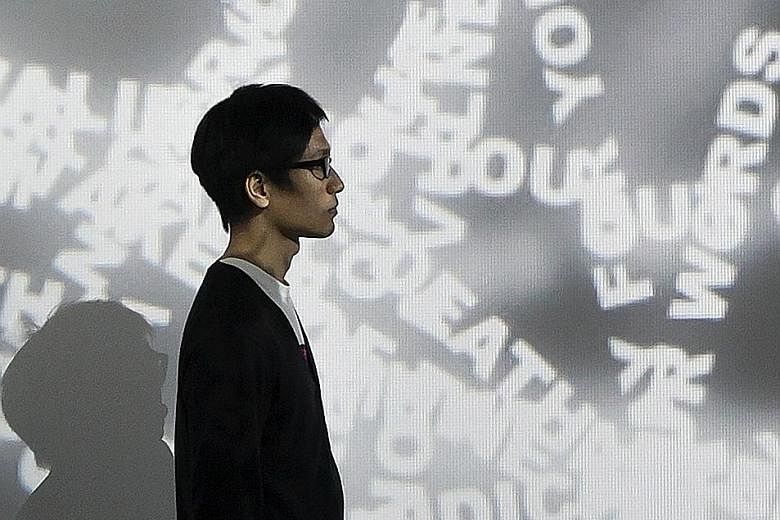HONG KONG • "I'm very polite. One must be polite," artist Tsang Kin Wah said in an interview last month at his spare one-room studio in an industrial area of Hong Kong.
"I used to never swear in real life, so I did so in my art," he said.
Tsang, 39, caught the attention of galleries and museums with his student work at the Chinese University of Hong Kong and Camberwell College of Arts in London.
What appeared from a distance as meticulous illustrations of flowers and paisley patterns were, on closer inspection, angry, vile strings of obscenities in English.
Tsang has since become an important part of the art scene. His work appeared at last year's Venice Biennale and is sought after by museums and collectors.
Soft-spoken and almost painfully courteous, he said he still has a hard time reading aloud the offensive words in his art.
His latest work, the first exhibition commissioned for the US$3-billion (S$4.1-billion) West Kowloon Cultural District here, may prove to be his darkest yet. The immersive multimedia installation, Nothing, opened on Sept 9 at the M+ Pavilion - the first of a planned 17 cultural spaces in the 40ha district.
Viewers enter Nothing through the pavilion's shiny stainless steel- clad terrace overlooking Victoria Harbour. Tsang has covered the interior with a similar surface, effectively creating a self-reflective experience for visitors.
Inside a darkened hall, film scenes (prisoners walking in a circle in A Clockwork Orange, for example) and clips from YouTube (a donkey trembling under a heavy load) are projected on the walls. His artwork is not overtly personal or confessional, but the feelings of outrage and inequality are clear.
His debut on the art-world stage came at the 2001 Hong Kong Biennale, where he presented inked stoneware with classically rendered Chinese figures, which, on further inspection, were seen to be engaged in private bodily functions.
In White Cube, at the John Batten Gallery in Hong Kong, he painted the walls with insulting phrases aimed at targets, including materialistic rich girls and art dealers. He won the US$25,000 Sovereign Foundation Asian Art Prize that year.
He was the first local artist that Pearl Lam, a Chinese gallery-world pioneer, chose when she opened her Hong Kong space in 2012.
For that solo show, he created Ecce Homo Trilogy, a multimedia installation that recalls the phrase attributed to Pontius Pilate when he presented Christ before his crucifixion, and the title of a book by Nietzsche. It features a video of the 1989 execution of the Romanian dictator, Nicolae Ceausescu, which deeply affected Tsang when he saw it on the news as a child.
"It's a work about perception," Ms Lam said. "There are very few contemporary artists who are true intellectuals, who are reading philosophy. His work challenges people's belief in religion and politics."
Tsang's work has been acquired by the Mori Art Museum in Tokyo and by high-profile collectors.
In November, he will be the only Hong Kong resident included in Tales Of Our Time - an exhibition of Chinese artists at the Guggenheim in New York.
The genesis of Nothing was a commission given to Tsang by the Hong Kong government to represent the city at last year's Venice Biennale. His response was an eerie multimedia installation called The Infinite Nothing, also inspired by Nietzsche. It had little of the boyish playfulness of his early paintings.
The M+ Pavilion had planned to reuse The Infinite Nothing for its opening this year. But it proved hard to take a work custom-made for a historic Italian building and adapt it to a shiny new Hong Kong art space.
In Venice, Tsang used light and sound to make viewers feel as if they were walking through a torrent of water, an effect impossible in Hong Kong. "You can't just cut and paste," he said.
A voracious reader of the morbid and obscure, Tsang began scouring books and online texts for inspiration. On his home computer is a folder of materials that led to Nothing, including documents on Sisyphus, Japanese kamikaze pilots and a 1775 English essay on suicide.
"I don't want to be obvious," he said when asked about those references to death and suicide. "A viewer should not be able to see an artwork's meaning immediately. One needs patience."
NYTIMES

